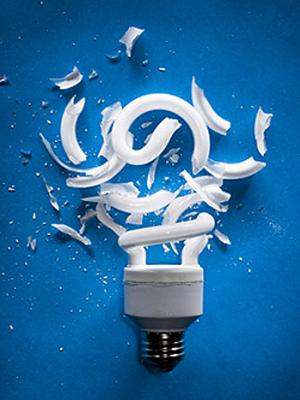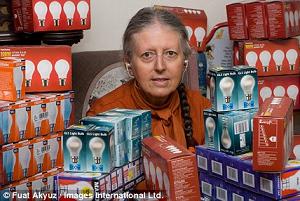Lightbulbs and Liberty: CFLs vs Incandescents
 | | The U.S.A.: God bless it! |
If there's one principle that should dictate our domestic policy in America, it is liberty. From what religion we want to practice to which brand of sunglasses we decide will best block out Jersey Shore, our country is supposed to be about the freedom to make our own choices. That's what the Bill of Rights is for, to specifically enumerate the rights that are off-limits to the government. However, as any decent Constitutional scholar will tell you, the people have far more rights than those listed in the Constitution and its amendments, because the Constitution is actually about what the government is and is not allowed to do. This is why certain trends in our increasingly naggy government are so troublesome. There is no specific right in the Bill of Rights that says two men can marry each other, for example, but that shouldn't matter, because there is nothing in the Constitution that gives the government the imperative to stop it.
Naturally, the government does have as much power as we decide to give it and it frequently uses that power to dictate how we should live our lives, for better or for worse. Laws exist that restrict what substances we can put in our bodies, what kinds of guns we can own and who can own them, which words we're allowed to use in public, and how much industrial waste we're allowed to put in our city's water reservoirs (turns out it's not very much). The vast majority of domestic political arguments in this country involve these laws and regulations, with several people arguing for and against each one with passion and/or vitriole. If you ask me, I think the burden of proof in these debates belongs with the side seeking to restrict liberty. Anybody wishing to impose a new law or regulation that seeks to dictate how we live or what we do needs to be able to prove that such a law or regulation is necessary for our mutual welfare.
There are limits, though. Simply proving that something is bad shouldn't be enough to justify a new law. For instance, it shouldn't be that hard to prove that listening to more than three straight hours of Kenny G is bad for your health, but that doesn't mean we should outlaw Kenny G's brand of smooth jazz or regulate how much radio stations are allowed to play. I don't claim that this is an easy line to draw, but that doesn't mean the line doesn't exist. I think we can all agree that some regulations not specifically covered by the Constitution--like the law forbidding your average Joe from wearing a blindfold while driving--are absolutely necessary for our society to remain healthy and stable. I think we can all also agree, though, that there are some regulations--like all those thankfully repealed segregation laws of a few decades ago--that go too far.
 | | Thomas Edison: great American innovator and mortal enemy of the green movement |
Which brings me, at long last, to an iconic American invention, the incandescent lightbulb. Not long ago, a law was passed that will effectively ban most incandescent lightbulbs--those obligatory lightbulbs most of us use--from being produced or sold, by phasing them out from 2012 to 2014. The reasoning behind the ban is that there are better, cheaper, and more efficient lightbulbs available (mainly CFLs, which I will discuss shortly), and that we have to do as much as we can to reduce energy consumption in America. The problem with this new regulation is that a system already exists to replace older, outdated goods with newer and better ones: capitalism. At best, this new regulation is redundant, but at worst, it's trying to strongarm change, something that has never worked well.
I know a lot of people these days think "capitalism" is a bad word and believe that having faith in "market forces" is akin to wearing a tinfoil hat, but you shouldn't underestimate the power of human greed on a large scale. People want the best they can get, and they want to spend as little for it as possible. Therefore, if a lightbulb were on the market today that was cheaper and better than the ones most of us use, we wouldn't need the government to ban incandescent lightbulbs, because people would, over time, stop buying them. That's how it works, and that reveals the open secret of the legislation: the cheaper, better, and more efficient lightbulb simply does not exist yet. You also don't need to offer businesses incentives to find one, because businesses know that the first to figure it out will make a killing.
So what about compact fluorescents (CFLs)? As you probably know by now, CFLs are fluorescent lightbulbs that are spun into the rough shape of an incandescent lightbulb. CFL enthusiasts argue that they are better than incandescents for a number of reasons. CFLs are, most importantly, much more energy efficient than incandescents, which means that they do, in fact, reduce energy consumption. The bulbs are more expensive, however, but they last many times as long (if used properly), meaning that they essentially pay for themselves in the long-run. They are interchangeable with incandescent bulbs, so there is no real hassle in replacing your existing bulbs. If this were the end of the story--because it's all true--I imagine CFLs would be in nearly every home in America by now.
 | | Somebody call Hazmat! |
Unfortunately, there's a lot more to discuss, because there are other important differences between incandescents and CFLs. First of all, CFLs, like all fluorescents, contain small amounts of mercury vapor, which makes their disposal troublesome. Mercury is an especially dangerous poison because it, like all other heavy metals, cannot be naturally disposed by the human body; it builds up in your bloodstream over the course of your life. Mercury is notably dangerous around the elderly, the immunosuppressed, and small children. This is why the miniscule amounts of mercury in old thermometers caused us to change our thermometers. Environmentalists aren't swayed by this mercury threat, though, because the mercury released into the environment by CFLs--both through manufacturing and disposal--is proportionally less than the mercury released by the manufacturing of incandescents, assuming everyone disposes of their used or broken CFLs properly. Still, human exposure is significantly higher around CFLs than around incandescents, and that's the real danger.
Secondly, fluorescents release a small amount of UV radiation. The danger to people is minimal (although if CFLs were the standard everywhere you went, you would be exposed to that radiation much more than you already are), but there is a danger to other things, like certain paintings and textiles. The UV radiation in fluorescents can also cause significant polymer degredation in anything plastic over time.
Next, CFLs don't "ignite" as quickly as incandescents, meaning that there's a warm-up period. When CFLs were young, this warm-up period was fairly ridiculous, but now there are CFLs on the market that light up much faster--within a few seconds--not to mention the new hybrid technologies that use a secondary halogen bulb to reduce the lighting time to less than that of incandescents. However, these new technologies sacrifice quite a bit of the light's lifespan and ultimate efficiency, making them a little counter-productive.
 | | This British woman is defying the British government, all because she has light-sensitive epilepsy, the selfish witch |
CFLs also aren't as bright as incandescents. Again, there are CFLs on the market that make up for this with newer and brighter versions, but just like before, they sacrifice efficiency. Worse than that, however, is that fluorescent light is much more damaging to people who are light-sensitive because they take up more of the light spectrum than your standard incandescent bulbs. Anybody who suffers from migraines knows the difference between being in a room lit by fluorescents and a room lit by incandescents. As of yet, there are no CFLs on the market that adjust for this reality. CFLs also don't like being too confined or heated, meaning they are not made for enclosed light fixtures. They also can't be dimmed as easily as incandescents; dimmer CFLs do exist, but they don't work with dimmer switches designed for incandescents and are more expensive than standard CFLs (which are, remember, more expensive than incandescents, all of which can be dimmed). CFLs can also interfere with remote controls that rely on infra-red light, which includes most television remotes (and Wii remotes!). CFLs don't react well to timers, motion sensors, and similar devices. Fluorescent lights get dimmer and dimmer over time, meaning that their extreme lifespan is an exaggeration because most consumers will replace them long before that lifespan is fully spent.
There are plenty of other problems, too, but the bottom line is that CFLs still have a way to go before they become as popular as incandescents. If the government were willing to give it enough time, I have no doubt CFLs or some other technology would deal with all the above problems, dethrone incandescent bulbs, and lead to a new paradigm in artificial lighting. However, by banning a technology, they are putting unnecessary roadblocks in place and actively reducing the incentive to innovate. What if there is a way to vastly improve incandescent bulbs that nobody's thought of yet? In the absence of an overreactive ban, that technology might be found by the manufacturers of incandescent bulbs and, in the long-run, our energy consumption might be lower than it otherwise would be and people would be far less inconvenienced.
I know it seems like such a small thing to get up in arms about, but this is just a microchosm, a tiny example of tyranny. Our government should not exist to nanny us into doing what it thinks we should do. That's exactly what our Constitution is supposed to prevent. You let them come for your lightbulbs, who knows what they'll come for next? I'm sure that, in a matter of years, CFLs or some other technology will be better than incandescents, and on that day, I'll make the switch. Until then, however, I'm buying as many incandescent bulbs as I can and storing them up for later use. That's my right, my choice, my liberty. If I'm not allowed to use the bulbs of my choice anymore, the government will have to break into my house and take them from my cold, dead fingers.
-e. magill 3/30/2011
|
|